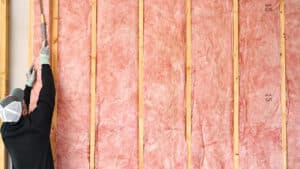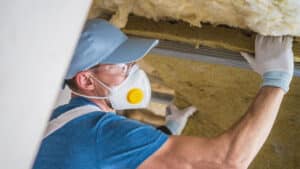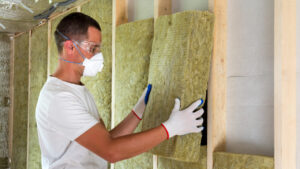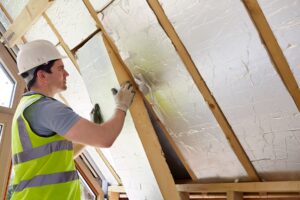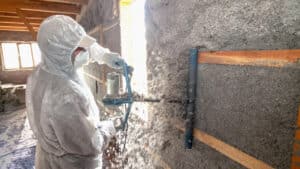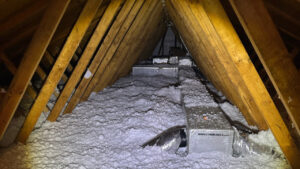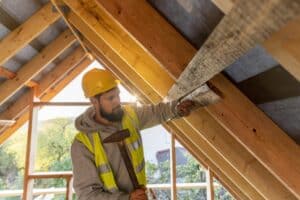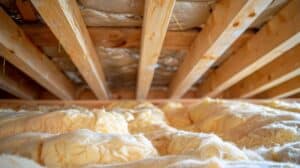Are you tired of hearing every sound from your neighbors or the street outside? Home insulation isn’t just about temperature control; it’s a key player in soundproofing your Virginia home.
This article will explore how different insulation materials, from attic to wall insulation, can reduce noise transmission. We’ll cover installation techniques for ceilings and walls, and discuss the benefits of enhanced soundproofing.
By the end, you’ll understand how proper insulation can create a quieter, more peaceful living space without resorting to costly foam solutions.
Understanding Sound Transmission

Sound moves through the air and other materials in waves and can be divided into two main types:
- Airborne Noise: This includes things like talking, music, and traffic sounds.
- Impact Noise: This comes from vibrations caused by footsteps or moving objects.
When sound hits walls, floors, or ceilings, it can either pass through, be absorbed, or bounce back. If a space isn’t well insulated, sound can easily travel through, leading to noise leaks and less privacy. Good insulation helps reduce this by absorbing sound and turning it into heat.
Different types of insulation materials offer varying degrees of soundproofing capabilities. Fiberglass and cellulose insulation, commonly used in walls and attics, can significantly reduce airborne sound transmission. These materials also provide thermal insulation, enhancing energy efficiency and heat retention.
Soundproofing extends beyond just walls and floors. Ducts and other openings can act as conduits for noise. Proper insulation of these areas is essential for comprehensive noise reduction. Here’s a breakdown of common sound transmission pathways and their impact:
| Pathway | Impact on Sound Transmission | Insulation Solution |
|---|---|---|
| Walls | High | Fiberglass or cellulose insulation |
| Floors | Medium | Acoustic underlayment |
| Roof/Attic | Medium | Blown-in insulation |
| Ducts | Low to Medium | Duct wrap insulation |
Insulation Materials and Their Soundproofing Properties
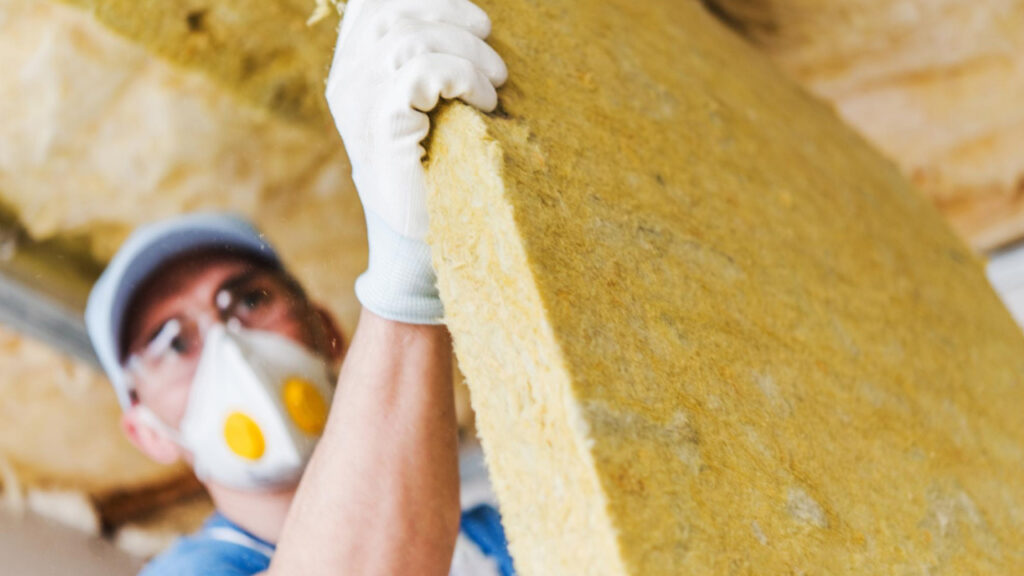
Various insulation materials enhance soundproofing and thermal insulation in living spaces. Mineral wool, fiberglass, cellulose, spray foam, and mass-loaded vinyl offer distinct sound absorption properties.
These materials not only improve acoustic comfort but also contribute to efficient air conditioning. Understanding their unique characteristics helps homeowners choose the best solution for their soundproofing needs.
Mineral Wool (Rock Wool)
Mineral wool, also known as rock wool, offers excellent soundproofing properties with a high sound transmission class (STC) rating. It effectively reduces noise transfer between rooms when installed on walls, ceilings, or floors.
When combined with drywall, mineral wool can significantly improve sound insulation, creating a quieter living environment. Known for its density and fibrous structure, mineral wool excels at minimizing both airborne and impact noise. Its ability to absorb sound makes it a top choice for soundproofing applications.
Fiberglass Insulation
While primarily used for thermal insulation, fiberglass also provides some noise reduction benefits. It is effective at absorbing airborne sounds but may not be as efficient against impact noise. Its dense structure absorbs sound waves, minimizing reverberation and enhancing noise control in homes.
When installed in walls, floors, and ceilings, fiberglass insulation creates a barrier that dampens both airborne and impact noise. Additionally, its thermal properties contribute to energy efficiency, making it a dual-purpose solution for homeowners seeking improved acoustics and reduced energy costs:
| Property | Fiberglass Insulation Performance |
|---|---|
| Sound Absorption | High |
| Noise Reduction | Significant |
| Energy Efficiency | Excellent |
| Installation Ease | Moderate |
Cellulose Insulation
Cellulose insulation, made from recycled paper products, offers excellent soundproofing properties while providing eco-friendly thermal insulation. Its dense structure effectively absorbs sound waves, reducing noise transmission between rooms and from external sources.
Cellulose insulation can be blown into wall cavities, attics, and floors, making it versatile for both new construction and retrofitting existing homes. Unlike fiberglass or wool insulation, cellulose’s unique composition allows it to fill small gaps and crevices, creating a more comprehensive sound barrier that also helps prevent air leakage around plumbing and electrical fixtures.
Spray Foam Insulation
Spray foam insulation excels in soundproofing by creating an airtight seal that blocks noise transmission through walls, ceilings, and floors. This type provides excellent air sealing properties and decent noise reduction. Open-cell spray foam is particularly effective due to its lower density, which allows for better absorption of sound waves.
This comprehensive coverage not only enhances sound insulation but also contributes to increased productivity in home offices or quiet spaces by minimizing external disturbances.
Mass Loaded Vinyl (MLV)
Mass Loaded Vinyl (MLV) offers exceptional noise reduction properties, making it a valuable addition to home insulation strategies. This dense, flexible material effectively blocks sound transmission through walls, floors, and ceilings, addressing noise pollution concerns in residential spaces.
MLV can be used in conjunction with other insulation types, such as spray foam or fiberglass, to enhance overall soundproofing performance. Its versatility allows for application in various areas, including pipe insulation and even as a noise-dampening layer beneath furniture, providing comprehensive sound control throughout the home.
Installation Considerations
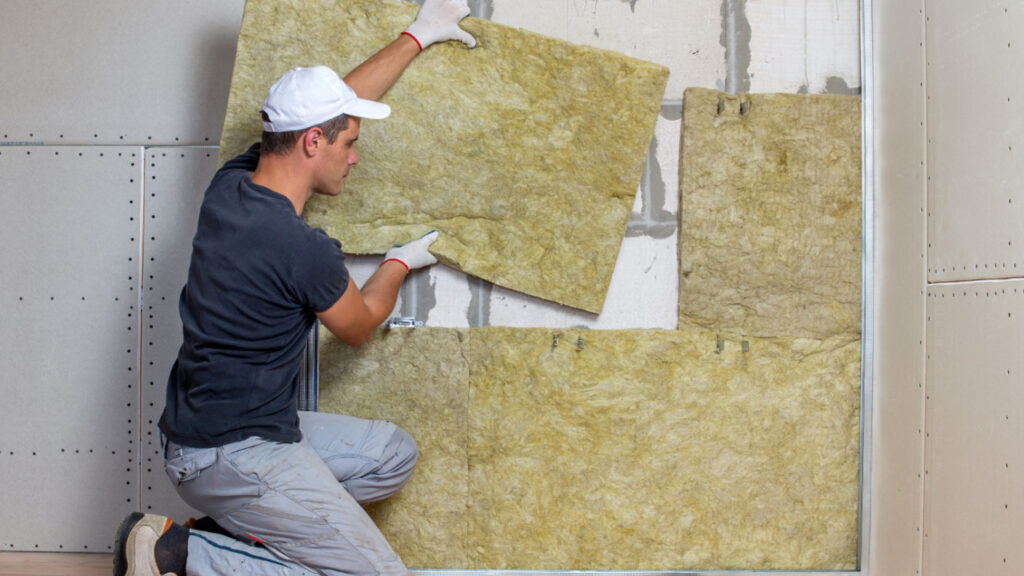
Proper installation techniques are crucial for maximizing insulation’s soundproofing benefits. The following methods, combined with quality insulation materials, significantly improve a home’s acoustic environment and overall comfort.
Sealing Gaps
Sealing gaps in a home’s structure plays a crucial role in enhancing soundproofing effectiveness. In basements, where low-frequency sounds like bass from music can easily penetrate, proper gap sealing becomes especially important.
Homeowners in areas with varying climates should pay particular attention to this aspect, as it not only improves acoustics but also increases energy efficiency and real estate value. Professional insulation contractors often recommend using acoustic sealants or specialized bass traps to address these gaps effectively.
Using Resilient Channels
Resilient channels, often made of metal, enhance soundproofing when combined with insulation materials like mineral wool. These channels create a gap between the drywall and studs, effectively reducing sound transmission through walls and ceilings.
In bedrooms, where maintaining a low decibel level is essential for restful sleep, resilient channels can significantly improve acoustic comfort. Homeowners should consider their zip code when selecting insulation and soundproofing methods, as local building codes and climate conditions may influence the most effective approach. For more detailed guidance, they might find the insulation checklist useful in understanding what areas of their home to prioritize.
Acoustic Caulk
Acoustic caulk serves as a crucial building material for enhancing soundproofing during insulation installation. This specialized sealant effectively blocks low-frequency noise transmission through small gaps and cracks in walls, ceilings, and floors.
When used in conjunction with other insulation methods, such as blanket insulation in a garage or around bookcases, acoustic caulk significantly reduces sound leakage, creating a more peaceful living environment.
Benefits of Enhanced Soundproofing

Proper insulation acts as a firewall against noise, enhancing interior design aesthetics without relying on headphones. This comprehensive approach to building acoustics creates a more peaceful living environment, addressing both practical and wellness concerns for homeowners.
Improved Privacy
Enhanced soundproofing through home insulation improves privacy within living spaces. By reducing sound transmission between rooms and from external sources, insulation creates a more secluded environment, particularly beneficial in multi-story buildings or homes with shared walls.
This improved acoustic isolation allows for greater freedom in activities without disturbing others, whether it’s operating HVAC systems, opening windows, or simply enjoying personal time in any square footage of the home. In cities where urban noise pollution can be a concern, proper insulation becomes crucial for maintaining a sense of privacy and tranquility indoors.
Increased Comfort
Enhanced soundproofing through home insulation significantly increases comfort by creating an effective sound barrier, reducing external noise intrusion. During intense heat waves, properly insulated spaces maintain more consistent temperatures while keeping outdoor noise at bay. In places where urban development continues to expand, properly installed insulation with strategically placed screws can transform living spaces into peaceful havens.
This improved acoustic environment not only enhances overall quality of life but also positively impacts health by reducing stress associated with constant noise exposure. While the initial cost may vary, the long-term benefits of a quieter home far outweigh the investment.
Health Benefits
Enhanced soundproofing through home insulation offers significant health benefits, even for those on a budget. By creating an effective acoustic barrier, insulation reduces stress-inducing noise pollution, promoting better sleep and overall well-being.
This mass reduction in external sounds contributes to a more peaceful living environment, acoustically tailored to support mental and physical health:
- Improved sleep quality
- Reduced stress levels
- Enhanced concentration and productivity
- Lower risk of noise-related health issues
- Increased overall comfort and relaxation
Universal Insulation Doctor’s Professional Insulation Services
At Universal Insulation Doctor, we understand the significance of upholding effective insulation in your residence. Our reliable insulation service is designed to elevate the coziness and energy efficiency of your attic living areas.
We are one of the top insulation companies operating in and around Virginia, going strong for ten years. With an A+ rating from the Better Business Bureau, we have proven time and again that customer satisfaction is our top priority.
Whether you need work done in your attic, crawl space, or somewhere in between, we’ll be there to make sure it gets done right.
Contact Universal Insulation Doctor today to arrange a professional insulation service in Portsmouth. Call us at 757-962-0340 and discover the remarkable difference that expertise in the insulation industry can bring!
Frequently Asked Questions
How does insulation reduce noise in a home?
Insulation reduces noise in homes by absorbing sound waves and preventing their transmission through walls, floors, and ceilings. Dense materials like fiberglass and cellulose insulation create barriers that dampen vibrations, minimizing the transfer of both external and internal noises, and resulting in a quieter living environment.
Which insulation materials are most effective for soundproofing?
Fiberglass and cellulose are effective for soundproofing, but dense materials like mineral wool and foam board excel. These insulations absorb sound waves, reducing noise transmission between rooms or from outside. The best choice depends on the specific application and budget constraints. For more details, you might want to consult with professionals who specialize in these services, such as those at insulation services in Norfolk.
Can existing insulation be upgraded for better sound reduction?
Yes, existing insulation can be upgraded for better sound reduction. Adding a layer of dense insulation materials like mineral wool or foam boards can significantly improve sound dampening. Additionally, sealing air gaps and installing sound-absorbing panels can enhance overall noise reduction in a home.
What are the key areas to insulate for maximum soundproofing?
To achieve maximum soundproofing, focus on insulating walls, floors, ceilings, and windows. Use dense materials like mass-loaded vinyl, acoustic panels, and soundproof curtains. Don't forget to seal gaps and cracks, as sound can easily penetrate even small openings.
How does improved soundproofing affect energy efficiency in a home?
Improved soundproofing often enhances energy efficiency in homes. Materials used for soundproofing, such as dense insulation and sealed windows, also help prevent heat transfer. This dual-purpose approach reduces noise pollution while simultaneously lowering heating and cooling costs, creating a more comfortable and energy-efficient living space.

